NSB202 Assessment 2: Yarning in a Good Way and Health Disparity
VerifiedAdded on 2022/12/26
|10
|2609
|76
Report
AI Summary
This report, prepared for the NSB202 course, critically examines the health disparities faced by Aboriginal and Torres Strait Islander peoples in Australia, focusing on the 'Closing the Gap' initiative. It explores the historical context, policy interventions, and outcomes related to health inequality, including discussions on funding challenges and the impact of the initiative. The report analyzes the roles of patient escorts and Aboriginal hospital liaison officers in improving healthcare access and cultural sensitivity. It highlights the importance of culturally safe practices and community engagement in addressing the holistic needs of Indigenous Australians. Furthermore, the report evaluates the effectiveness of various strategies aimed at improving health outcomes, providing insights into the complexities of healthcare delivery in remote and urban settings and the ongoing efforts to achieve health equity. The report concludes by emphasizing the need for continued efforts and a commitment to addressing the systemic issues that contribute to health inequalities.
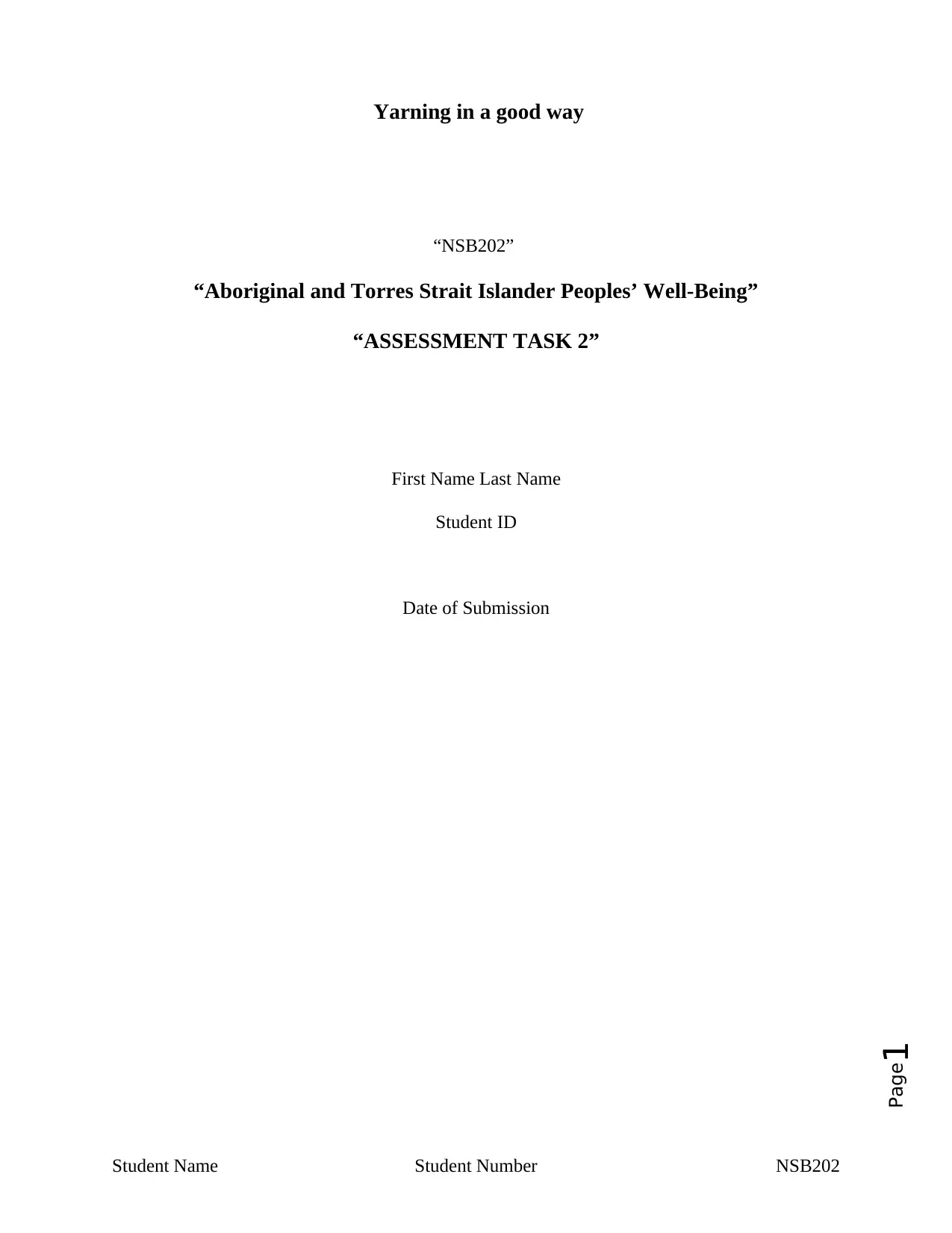
Page1
Yarning in a good way
“NSB202”
“Aboriginal and Torres Strait Islander Peoples’ Well-Being”
“ASSESSMENT TASK 2”
First Name Last Name
Student ID
Date of Submission
Student Name Student Number NSB202
Yarning in a good way
“NSB202”
“Aboriginal and Torres Strait Islander Peoples’ Well-Being”
“ASSESSMENT TASK 2”
First Name Last Name
Student ID
Date of Submission
Student Name Student Number NSB202
Paraphrase This Document
Need a fresh take? Get an instant paraphrase of this document with our AI Paraphraser
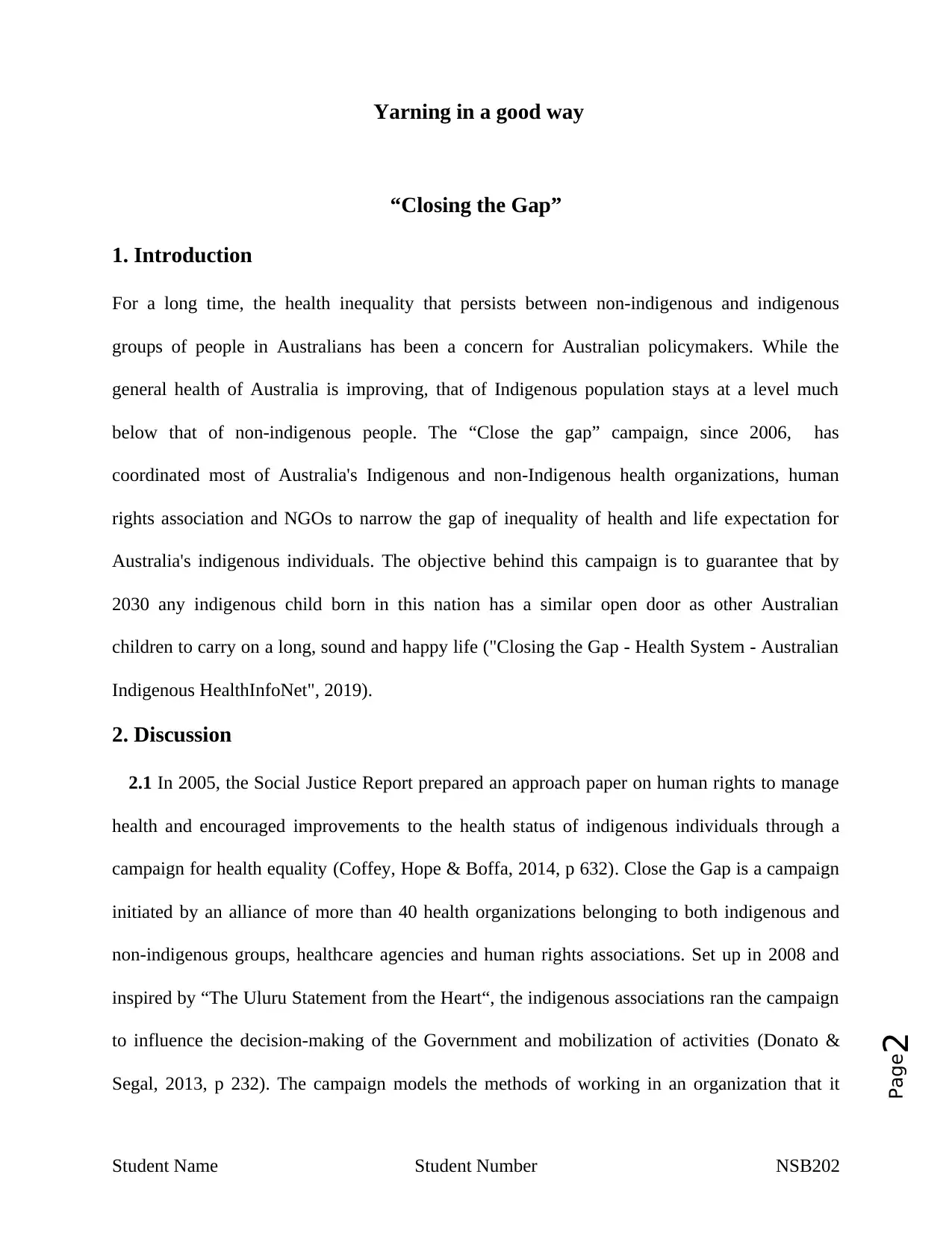
Page2
Yarning in a good way
“Closing the Gap”
1. Introduction
For a long time, the health inequality that persists between non-indigenous and indigenous
groups of people in Australians has been a concern for Australian policymakers. While the
general health of Australia is improving, that of Indigenous population stays at a level much
below that of non-indigenous people. The “Close the gap” campaign, since 2006, has
coordinated most of Australia's Indigenous and non-Indigenous health organizations, human
rights association and NGOs to narrow the gap of inequality of health and life expectation for
Australia's indigenous individuals. The objective behind this campaign is to guarantee that by
2030 any indigenous child born in this nation has a similar open door as other Australian
children to carry on a long, sound and happy life ("Closing the Gap - Health System - Australian
Indigenous HealthInfoNet", 2019).
2. Discussion
2.1 In 2005, the Social Justice Report prepared an approach paper on human rights to manage
health and encouraged improvements to the health status of indigenous individuals through a
campaign for health equality (Coffey, Hope & Boffa, 2014, p 632). Close the Gap is a campaign
initiated by an alliance of more than 40 health organizations belonging to both indigenous and
non-indigenous groups, healthcare agencies and human rights associations. Set up in 2008 and
inspired by “The Uluru Statement from the Heart“, the indigenous associations ran the campaign
to influence the decision-making of the Government and mobilization of activities (Donato &
Segal, 2013, p 232). The campaign models the methods of working in an organization that it
Student Name Student Number NSB202
Yarning in a good way
“Closing the Gap”
1. Introduction
For a long time, the health inequality that persists between non-indigenous and indigenous
groups of people in Australians has been a concern for Australian policymakers. While the
general health of Australia is improving, that of Indigenous population stays at a level much
below that of non-indigenous people. The “Close the gap” campaign, since 2006, has
coordinated most of Australia's Indigenous and non-Indigenous health organizations, human
rights association and NGOs to narrow the gap of inequality of health and life expectation for
Australia's indigenous individuals. The objective behind this campaign is to guarantee that by
2030 any indigenous child born in this nation has a similar open door as other Australian
children to carry on a long, sound and happy life ("Closing the Gap - Health System - Australian
Indigenous HealthInfoNet", 2019).
2. Discussion
2.1 In 2005, the Social Justice Report prepared an approach paper on human rights to manage
health and encouraged improvements to the health status of indigenous individuals through a
campaign for health equality (Coffey, Hope & Boffa, 2014, p 632). Close the Gap is a campaign
initiated by an alliance of more than 40 health organizations belonging to both indigenous and
non-indigenous groups, healthcare agencies and human rights associations. Set up in 2008 and
inspired by “The Uluru Statement from the Heart“, the indigenous associations ran the campaign
to influence the decision-making of the Government and mobilization of activities (Donato &
Segal, 2013, p 232). The campaign models the methods of working in an organization that it
Student Name Student Number NSB202
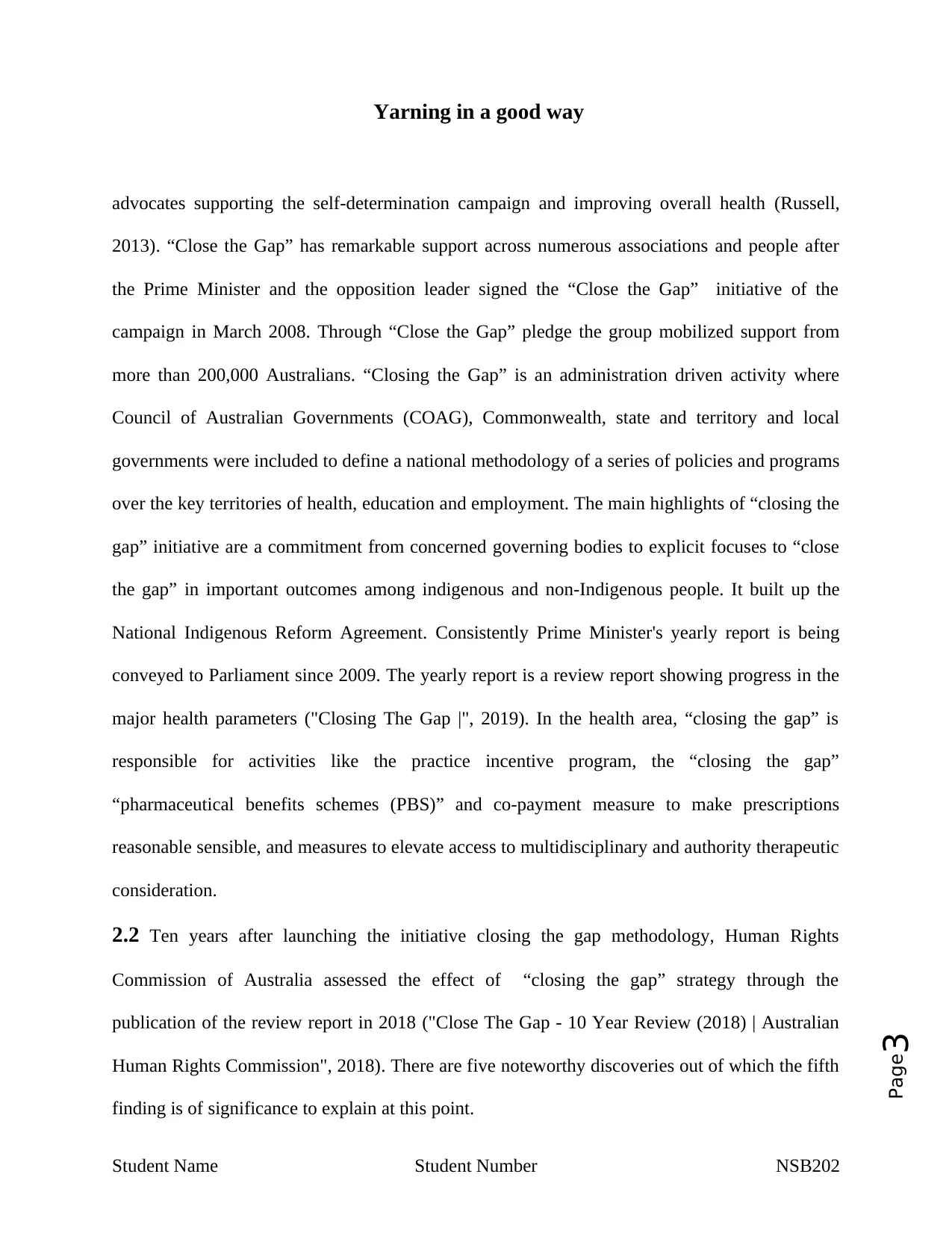
Page3
Yarning in a good way
advocates supporting the self-determination campaign and improving overall health (Russell,
2013). “Close the Gap” has remarkable support across numerous associations and people after
the Prime Minister and the opposition leader signed the “Close the Gap” initiative of the
campaign in March 2008. Through “Close the Gap” pledge the group mobilized support from
more than 200,000 Australians. “Closing the Gap” is an administration driven activity where
Council of Australian Governments (COAG), Commonwealth, state and territory and local
governments were included to define a national methodology of a series of policies and programs
over the key territories of health, education and employment. The main highlights of “closing the
gap” initiative are a commitment from concerned governing bodies to explicit focuses to “close
the gap” in important outcomes among indigenous and non-Indigenous people. It built up the
National Indigenous Reform Agreement. Consistently Prime Minister's yearly report is being
conveyed to Parliament since 2009. The yearly report is a review report showing progress in the
major health parameters ("Closing The Gap |", 2019). In the health area, “closing the gap” is
responsible for activities like the practice incentive program, the “closing the gap”
“pharmaceutical benefits schemes (PBS)” and co-payment measure to make prescriptions
reasonable sensible, and measures to elevate access to multidisciplinary and authority therapeutic
consideration.
2.2 Ten years after launching the initiative closing the gap methodology, Human Rights
Commission of Australia assessed the effect of “closing the gap” strategy through the
publication of the review report in 2018 ("Close The Gap - 10 Year Review (2018) | Australian
Human Rights Commission", 2018). There are five noteworthy discoveries out of which the fifth
finding is of significance to explain at this point.
Student Name Student Number NSB202
Yarning in a good way
advocates supporting the self-determination campaign and improving overall health (Russell,
2013). “Close the Gap” has remarkable support across numerous associations and people after
the Prime Minister and the opposition leader signed the “Close the Gap” initiative of the
campaign in March 2008. Through “Close the Gap” pledge the group mobilized support from
more than 200,000 Australians. “Closing the Gap” is an administration driven activity where
Council of Australian Governments (COAG), Commonwealth, state and territory and local
governments were included to define a national methodology of a series of policies and programs
over the key territories of health, education and employment. The main highlights of “closing the
gap” initiative are a commitment from concerned governing bodies to explicit focuses to “close
the gap” in important outcomes among indigenous and non-Indigenous people. It built up the
National Indigenous Reform Agreement. Consistently Prime Minister's yearly report is being
conveyed to Parliament since 2009. The yearly report is a review report showing progress in the
major health parameters ("Closing The Gap |", 2019). In the health area, “closing the gap” is
responsible for activities like the practice incentive program, the “closing the gap”
“pharmaceutical benefits schemes (PBS)” and co-payment measure to make prescriptions
reasonable sensible, and measures to elevate access to multidisciplinary and authority therapeutic
consideration.
2.2 Ten years after launching the initiative closing the gap methodology, Human Rights
Commission of Australia assessed the effect of “closing the gap” strategy through the
publication of the review report in 2018 ("Close The Gap - 10 Year Review (2018) | Australian
Human Rights Commission", 2018). There are five noteworthy discoveries out of which the fifth
finding is of significance to explain at this point.
Student Name Student Number NSB202
⊘ This is a preview!⊘
Do you want full access?
Subscribe today to unlock all pages.

Trusted by 1+ million students worldwide
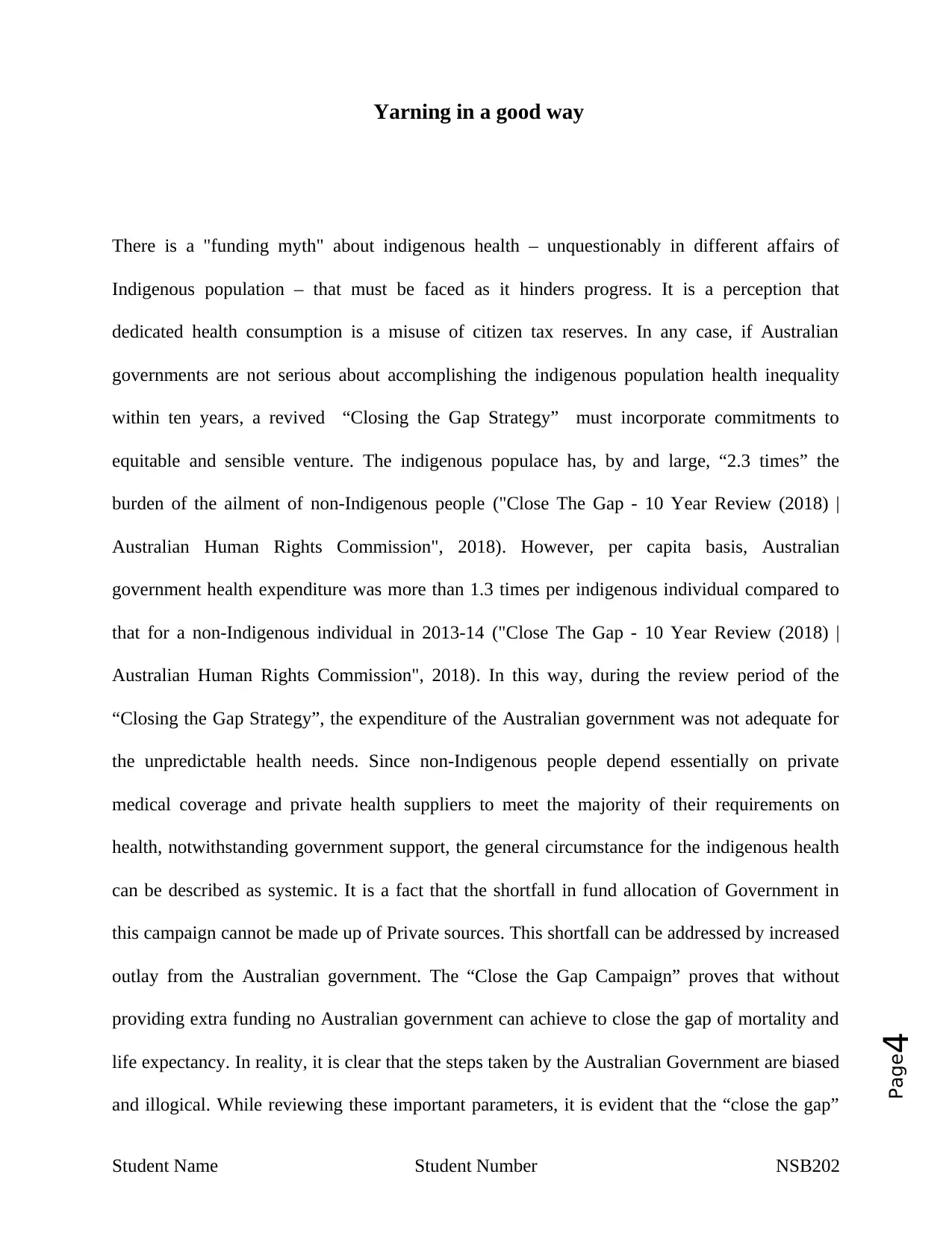
Page4
Yarning in a good way
There is a "funding myth" about indigenous health – unquestionably in different affairs of
Indigenous population – that must be faced as it hinders progress. It is a perception that
dedicated health consumption is a misuse of citizen tax reserves. In any case, if Australian
governments are not serious about accomplishing the indigenous population health inequality
within ten years, a revived “Closing the Gap Strategy” must incorporate commitments to
equitable and sensible venture. The indigenous populace has, by and large, “2.3 times” the
burden of the ailment of non-Indigenous people ("Close The Gap - 10 Year Review (2018) |
Australian Human Rights Commission", 2018). However, per capita basis, Australian
government health expenditure was more than 1.3 times per indigenous individual compared to
that for a non-Indigenous individual in 2013-14 ("Close The Gap - 10 Year Review (2018) |
Australian Human Rights Commission", 2018). In this way, during the review period of the
“Closing the Gap Strategy”, the expenditure of the Australian government was not adequate for
the unpredictable health needs. Since non-Indigenous people depend essentially on private
medical coverage and private health suppliers to meet the majority of their requirements on
health, notwithstanding government support, the general circumstance for the indigenous health
can be described as systemic. It is a fact that the shortfall in fund allocation of Government in
this campaign cannot be made up of Private sources. This shortfall can be addressed by increased
outlay from the Australian government. The “Close the Gap Campaign” proves that without
providing extra funding no Australian government can achieve to close the gap of mortality and
life expectancy. In reality, it is clear that the steps taken by the Australian Government are biased
and illogical. While reviewing these important parameters, it is evident that the “close the gap”
Student Name Student Number NSB202
Yarning in a good way
There is a "funding myth" about indigenous health – unquestionably in different affairs of
Indigenous population – that must be faced as it hinders progress. It is a perception that
dedicated health consumption is a misuse of citizen tax reserves. In any case, if Australian
governments are not serious about accomplishing the indigenous population health inequality
within ten years, a revived “Closing the Gap Strategy” must incorporate commitments to
equitable and sensible venture. The indigenous populace has, by and large, “2.3 times” the
burden of the ailment of non-Indigenous people ("Close The Gap - 10 Year Review (2018) |
Australian Human Rights Commission", 2018). However, per capita basis, Australian
government health expenditure was more than 1.3 times per indigenous individual compared to
that for a non-Indigenous individual in 2013-14 ("Close The Gap - 10 Year Review (2018) |
Australian Human Rights Commission", 2018). In this way, during the review period of the
“Closing the Gap Strategy”, the expenditure of the Australian government was not adequate for
the unpredictable health needs. Since non-Indigenous people depend essentially on private
medical coverage and private health suppliers to meet the majority of their requirements on
health, notwithstanding government support, the general circumstance for the indigenous health
can be described as systemic. It is a fact that the shortfall in fund allocation of Government in
this campaign cannot be made up of Private sources. This shortfall can be addressed by increased
outlay from the Australian government. The “Close the Gap Campaign” proves that without
providing extra funding no Australian government can achieve to close the gap of mortality and
life expectancy. In reality, it is clear that the steps taken by the Australian Government are biased
and illogical. While reviewing these important parameters, it is evident that the “close the gap”
Student Name Student Number NSB202
Paraphrase This Document
Need a fresh take? Get an instant paraphrase of this document with our AI Paraphraser
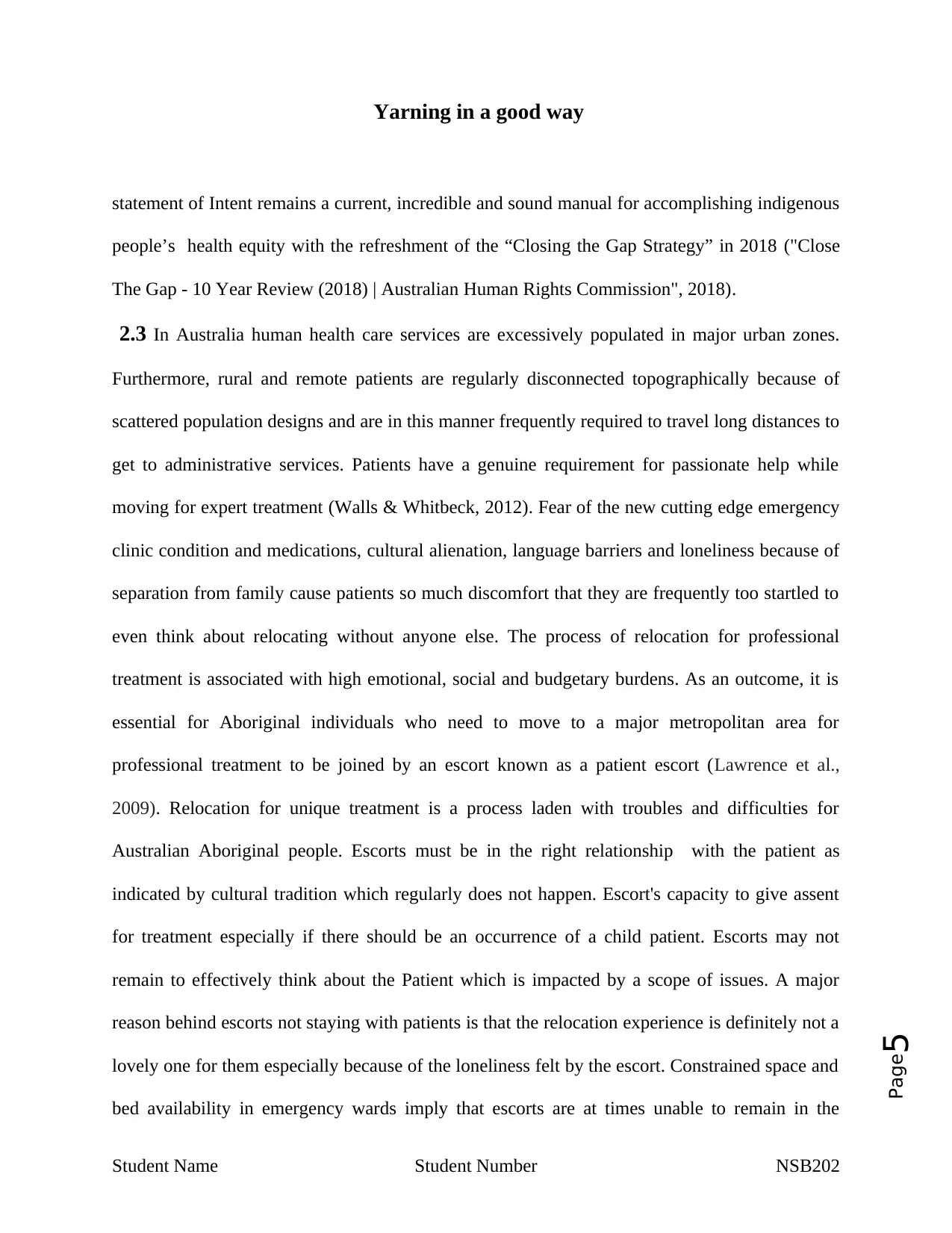
Page5
Yarning in a good way
statement of Intent remains a current, incredible and sound manual for accomplishing indigenous
people’s health equity with the refreshment of the “Closing the Gap Strategy” in 2018 ("Close
The Gap - 10 Year Review (2018) | Australian Human Rights Commission", 2018).
2.3 In Australia human health care services are excessively populated in major urban zones.
Furthermore, rural and remote patients are regularly disconnected topographically because of
scattered population designs and are in this manner frequently required to travel long distances to
get to administrative services. Patients have a genuine requirement for passionate help while
moving for expert treatment (Walls & Whitbeck, 2012). Fear of the new cutting edge emergency
clinic condition and medications, cultural alienation, language barriers and loneliness because of
separation from family cause patients so much discomfort that they are frequently too startled to
even think about relocating without anyone else. The process of relocation for professional
treatment is associated with high emotional, social and budgetary burdens. As an outcome, it is
essential for Aboriginal individuals who need to move to a major metropolitan area for
professional treatment to be joined by an escort known as a patient escort (Lawrence et al.,
2009). Relocation for unique treatment is a process laden with troubles and difficulties for
Australian Aboriginal people. Escorts must be in the right relationship with the patient as
indicated by cultural tradition which regularly does not happen. Escort's capacity to give assent
for treatment especially if there should be an occurrence of a child patient. Escorts may not
remain to effectively think about the Patient which is impacted by a scope of issues. A major
reason behind escorts not staying with patients is that the relocation experience is definitely not a
lovely one for them especially because of the loneliness felt by the escort. Constrained space and
bed availability in emergency wards imply that escorts are at times unable to remain in the
Student Name Student Number NSB202
Yarning in a good way
statement of Intent remains a current, incredible and sound manual for accomplishing indigenous
people’s health equity with the refreshment of the “Closing the Gap Strategy” in 2018 ("Close
The Gap - 10 Year Review (2018) | Australian Human Rights Commission", 2018).
2.3 In Australia human health care services are excessively populated in major urban zones.
Furthermore, rural and remote patients are regularly disconnected topographically because of
scattered population designs and are in this manner frequently required to travel long distances to
get to administrative services. Patients have a genuine requirement for passionate help while
moving for expert treatment (Walls & Whitbeck, 2012). Fear of the new cutting edge emergency
clinic condition and medications, cultural alienation, language barriers and loneliness because of
separation from family cause patients so much discomfort that they are frequently too startled to
even think about relocating without anyone else. The process of relocation for professional
treatment is associated with high emotional, social and budgetary burdens. As an outcome, it is
essential for Aboriginal individuals who need to move to a major metropolitan area for
professional treatment to be joined by an escort known as a patient escort (Lawrence et al.,
2009). Relocation for unique treatment is a process laden with troubles and difficulties for
Australian Aboriginal people. Escorts must be in the right relationship with the patient as
indicated by cultural tradition which regularly does not happen. Escort's capacity to give assent
for treatment especially if there should be an occurrence of a child patient. Escorts may not
remain to effectively think about the Patient which is impacted by a scope of issues. A major
reason behind escorts not staying with patients is that the relocation experience is definitely not a
lovely one for them especially because of the loneliness felt by the escort. Constrained space and
bed availability in emergency wards imply that escorts are at times unable to remain in the
Student Name Student Number NSB202
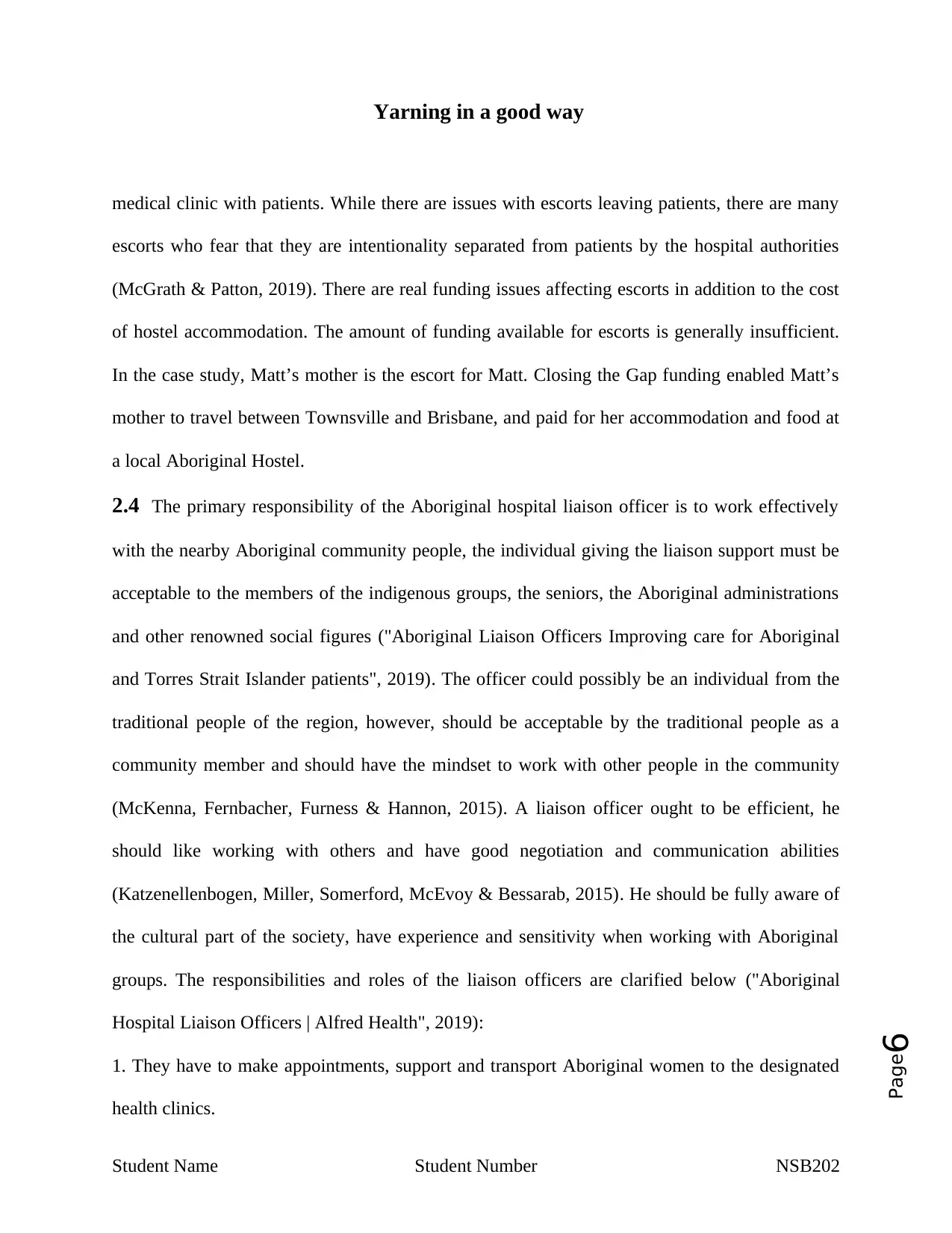
Page6
Yarning in a good way
medical clinic with patients. While there are issues with escorts leaving patients, there are many
escorts who fear that they are intentionality separated from patients by the hospital authorities
(McGrath & Patton, 2019). There are real funding issues affecting escorts in addition to the cost
of hostel accommodation. The amount of funding available for escorts is generally insufficient.
In the case study, Matt’s mother is the escort for Matt. Closing the Gap funding enabled Matt’s
mother to travel between Townsville and Brisbane, and paid for her accommodation and food at
a local Aboriginal Hostel.
2.4 The primary responsibility of the Aboriginal hospital liaison officer is to work effectively
with the nearby Aboriginal community people, the individual giving the liaison support must be
acceptable to the members of the indigenous groups, the seniors, the Aboriginal administrations
and other renowned social figures ("Aboriginal Liaison Officers Improving care for Aboriginal
and Torres Strait Islander patients", 2019). The officer could possibly be an individual from the
traditional people of the region, however, should be acceptable by the traditional people as a
community member and should have the mindset to work with other people in the community
(McKenna, Fernbacher, Furness & Hannon, 2015). A liaison officer ought to be efficient, he
should like working with others and have good negotiation and communication abilities
(Katzenellenbogen, Miller, Somerford, McEvoy & Bessarab, 2015). He should be fully aware of
the cultural part of the society, have experience and sensitivity when working with Aboriginal
groups. The responsibilities and roles of the liaison officers are clarified below ("Aboriginal
Hospital Liaison Officers | Alfred Health", 2019):
1. They have to make appointments, support and transport Aboriginal women to the designated
health clinics.
Student Name Student Number NSB202
Yarning in a good way
medical clinic with patients. While there are issues with escorts leaving patients, there are many
escorts who fear that they are intentionality separated from patients by the hospital authorities
(McGrath & Patton, 2019). There are real funding issues affecting escorts in addition to the cost
of hostel accommodation. The amount of funding available for escorts is generally insufficient.
In the case study, Matt’s mother is the escort for Matt. Closing the Gap funding enabled Matt’s
mother to travel between Townsville and Brisbane, and paid for her accommodation and food at
a local Aboriginal Hostel.
2.4 The primary responsibility of the Aboriginal hospital liaison officer is to work effectively
with the nearby Aboriginal community people, the individual giving the liaison support must be
acceptable to the members of the indigenous groups, the seniors, the Aboriginal administrations
and other renowned social figures ("Aboriginal Liaison Officers Improving care for Aboriginal
and Torres Strait Islander patients", 2019). The officer could possibly be an individual from the
traditional people of the region, however, should be acceptable by the traditional people as a
community member and should have the mindset to work with other people in the community
(McKenna, Fernbacher, Furness & Hannon, 2015). A liaison officer ought to be efficient, he
should like working with others and have good negotiation and communication abilities
(Katzenellenbogen, Miller, Somerford, McEvoy & Bessarab, 2015). He should be fully aware of
the cultural part of the society, have experience and sensitivity when working with Aboriginal
groups. The responsibilities and roles of the liaison officers are clarified below ("Aboriginal
Hospital Liaison Officers | Alfred Health", 2019):
1. They have to make appointments, support and transport Aboriginal women to the designated
health clinics.
Student Name Student Number NSB202
⊘ This is a preview!⊘
Do you want full access?
Subscribe today to unlock all pages.

Trusted by 1+ million students worldwide
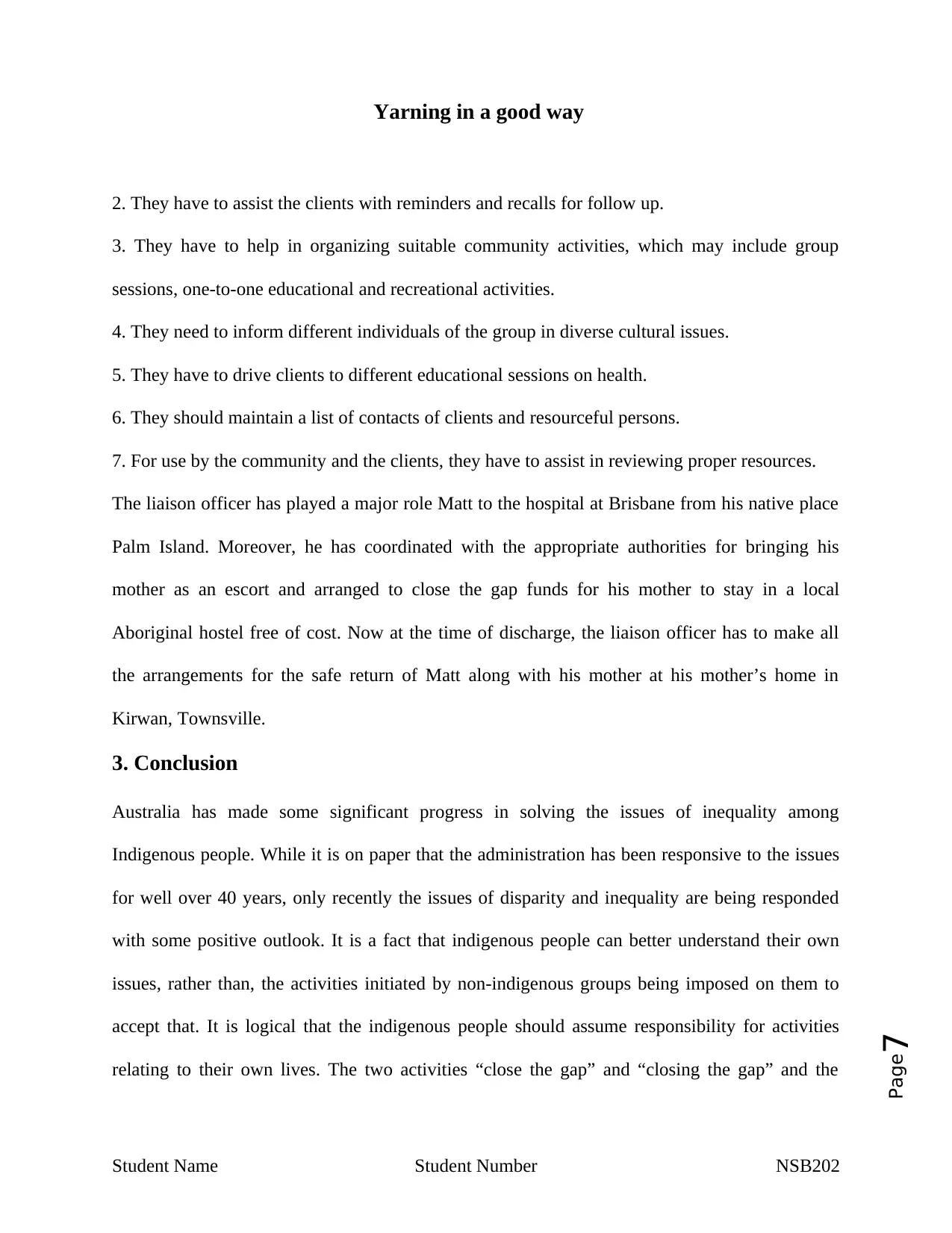
Page7
Yarning in a good way
2. They have to assist the clients with reminders and recalls for follow up.
3. They have to help in organizing suitable community activities, which may include group
sessions, one-to-one educational and recreational activities.
4. They need to inform different individuals of the group in diverse cultural issues.
5. They have to drive clients to different educational sessions on health.
6. They should maintain a list of contacts of clients and resourceful persons.
7. For use by the community and the clients, they have to assist in reviewing proper resources.
The liaison officer has played a major role Matt to the hospital at Brisbane from his native place
Palm Island. Moreover, he has coordinated with the appropriate authorities for bringing his
mother as an escort and arranged to close the gap funds for his mother to stay in a local
Aboriginal hostel free of cost. Now at the time of discharge, the liaison officer has to make all
the arrangements for the safe return of Matt along with his mother at his mother’s home in
Kirwan, Townsville.
3. Conclusion
Australia has made some significant progress in solving the issues of inequality among
Indigenous people. While it is on paper that the administration has been responsive to the issues
for well over 40 years, only recently the issues of disparity and inequality are being responded
with some positive outlook. It is a fact that indigenous people can better understand their own
issues, rather than, the activities initiated by non-indigenous groups being imposed on them to
accept that. It is logical that the indigenous people should assume responsibility for activities
relating to their own lives. The two activities “close the gap” and “closing the gap” and the
Student Name Student Number NSB202
Yarning in a good way
2. They have to assist the clients with reminders and recalls for follow up.
3. They have to help in organizing suitable community activities, which may include group
sessions, one-to-one educational and recreational activities.
4. They need to inform different individuals of the group in diverse cultural issues.
5. They have to drive clients to different educational sessions on health.
6. They should maintain a list of contacts of clients and resourceful persons.
7. For use by the community and the clients, they have to assist in reviewing proper resources.
The liaison officer has played a major role Matt to the hospital at Brisbane from his native place
Palm Island. Moreover, he has coordinated with the appropriate authorities for bringing his
mother as an escort and arranged to close the gap funds for his mother to stay in a local
Aboriginal hostel free of cost. Now at the time of discharge, the liaison officer has to make all
the arrangements for the safe return of Matt along with his mother at his mother’s home in
Kirwan, Townsville.
3. Conclusion
Australia has made some significant progress in solving the issues of inequality among
Indigenous people. While it is on paper that the administration has been responsive to the issues
for well over 40 years, only recently the issues of disparity and inequality are being responded
with some positive outlook. It is a fact that indigenous people can better understand their own
issues, rather than, the activities initiated by non-indigenous groups being imposed on them to
accept that. It is logical that the indigenous people should assume responsibility for activities
relating to their own lives. The two activities “close the gap” and “closing the gap” and the
Student Name Student Number NSB202
Paraphrase This Document
Need a fresh take? Get an instant paraphrase of this document with our AI Paraphraser
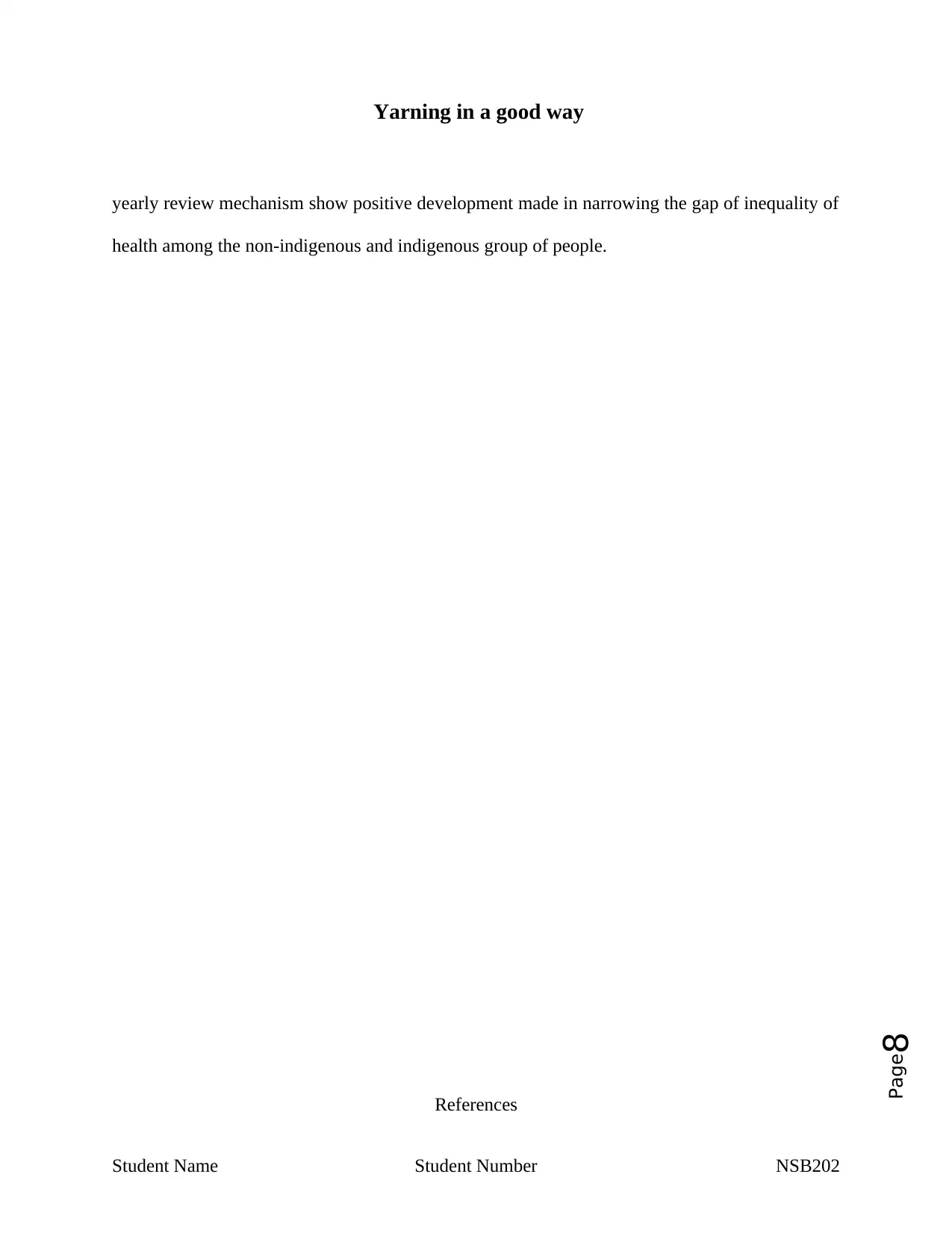
Page8
Yarning in a good way
yearly review mechanism show positive development made in narrowing the gap of inequality of
health among the non-indigenous and indigenous group of people.
References
Student Name Student Number NSB202
Yarning in a good way
yearly review mechanism show positive development made in narrowing the gap of inequality of
health among the non-indigenous and indigenous group of people.
References
Student Name Student Number NSB202
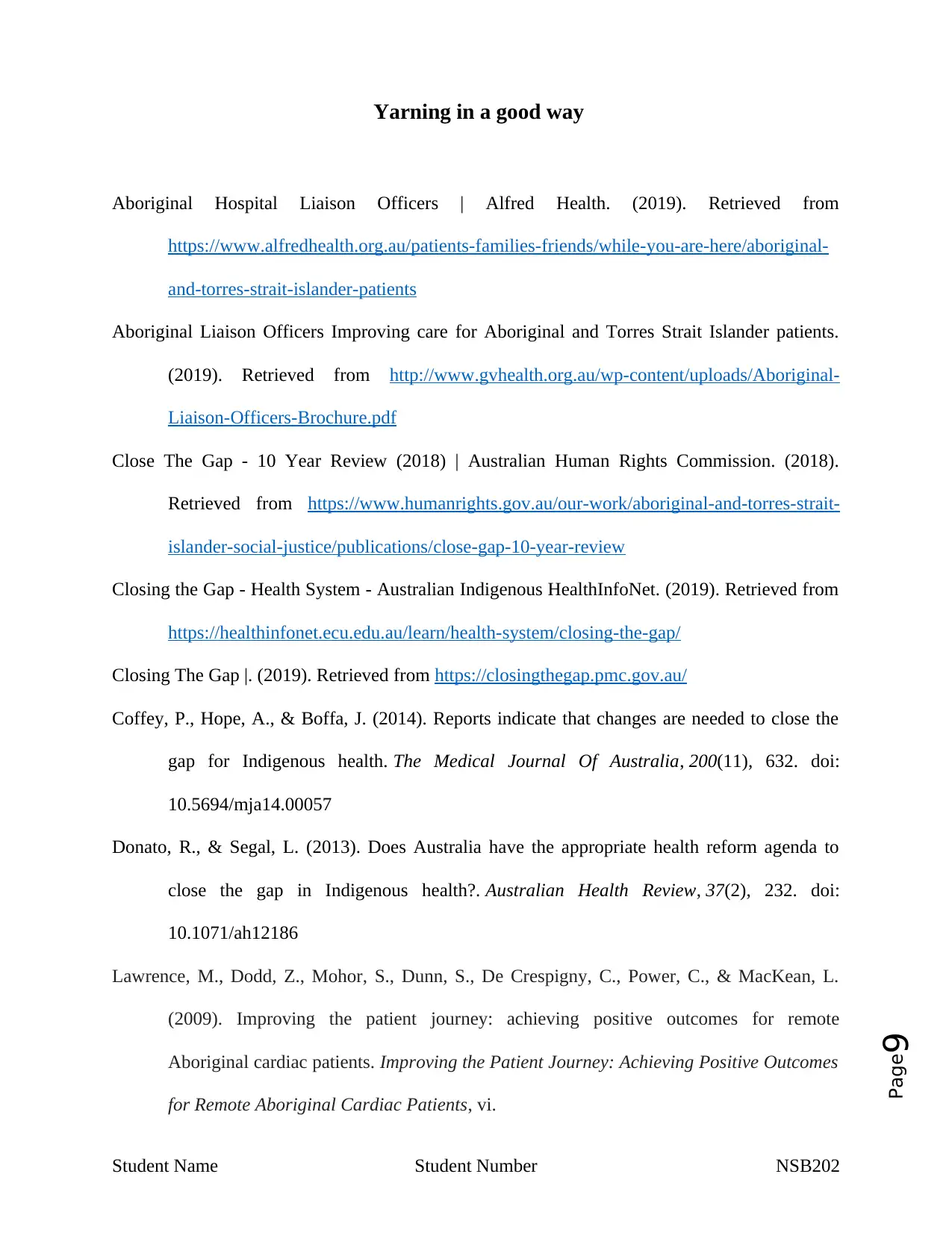
Page9
Yarning in a good way
Aboriginal Hospital Liaison Officers | Alfred Health. (2019). Retrieved from
https://www.alfredhealth.org.au/patients-families-friends/while-you-are-here/aboriginal-
and-torres-strait-islander-patients
Aboriginal Liaison Officers Improving care for Aboriginal and Torres Strait Islander patients.
(2019). Retrieved from http://www.gvhealth.org.au/wp-content/uploads/Aboriginal-
Liaison-Officers-Brochure.pdf
Close The Gap - 10 Year Review (2018) | Australian Human Rights Commission. (2018).
Retrieved from https://www.humanrights.gov.au/our-work/aboriginal-and-torres-strait-
islander-social-justice/publications/close-gap-10-year-review
Closing the Gap - Health System - Australian Indigenous HealthInfoNet. (2019). Retrieved from
https://healthinfonet.ecu.edu.au/learn/health-system/closing-the-gap/
Closing The Gap |. (2019). Retrieved from https://closingthegap.pmc.gov.au/
Coffey, P., Hope, A., & Boffa, J. (2014). Reports indicate that changes are needed to close the
gap for Indigenous health. The Medical Journal Of Australia, 200(11), 632. doi:
10.5694/mja14.00057
Donato, R., & Segal, L. (2013). Does Australia have the appropriate health reform agenda to
close the gap in Indigenous health?. Australian Health Review, 37(2), 232. doi:
10.1071/ah12186
Lawrence, M., Dodd, Z., Mohor, S., Dunn, S., De Crespigny, C., Power, C., & MacKean, L.
(2009). Improving the patient journey: achieving positive outcomes for remote
Aboriginal cardiac patients. Improving the Patient Journey: Achieving Positive Outcomes
for Remote Aboriginal Cardiac Patients, vi.
Student Name Student Number NSB202
Yarning in a good way
Aboriginal Hospital Liaison Officers | Alfred Health. (2019). Retrieved from
https://www.alfredhealth.org.au/patients-families-friends/while-you-are-here/aboriginal-
and-torres-strait-islander-patients
Aboriginal Liaison Officers Improving care for Aboriginal and Torres Strait Islander patients.
(2019). Retrieved from http://www.gvhealth.org.au/wp-content/uploads/Aboriginal-
Liaison-Officers-Brochure.pdf
Close The Gap - 10 Year Review (2018) | Australian Human Rights Commission. (2018).
Retrieved from https://www.humanrights.gov.au/our-work/aboriginal-and-torres-strait-
islander-social-justice/publications/close-gap-10-year-review
Closing the Gap - Health System - Australian Indigenous HealthInfoNet. (2019). Retrieved from
https://healthinfonet.ecu.edu.au/learn/health-system/closing-the-gap/
Closing The Gap |. (2019). Retrieved from https://closingthegap.pmc.gov.au/
Coffey, P., Hope, A., & Boffa, J. (2014). Reports indicate that changes are needed to close the
gap for Indigenous health. The Medical Journal Of Australia, 200(11), 632. doi:
10.5694/mja14.00057
Donato, R., & Segal, L. (2013). Does Australia have the appropriate health reform agenda to
close the gap in Indigenous health?. Australian Health Review, 37(2), 232. doi:
10.1071/ah12186
Lawrence, M., Dodd, Z., Mohor, S., Dunn, S., De Crespigny, C., Power, C., & MacKean, L.
(2009). Improving the patient journey: achieving positive outcomes for remote
Aboriginal cardiac patients. Improving the Patient Journey: Achieving Positive Outcomes
for Remote Aboriginal Cardiac Patients, vi.
Student Name Student Number NSB202
⊘ This is a preview!⊘
Do you want full access?
Subscribe today to unlock all pages.

Trusted by 1+ million students worldwide
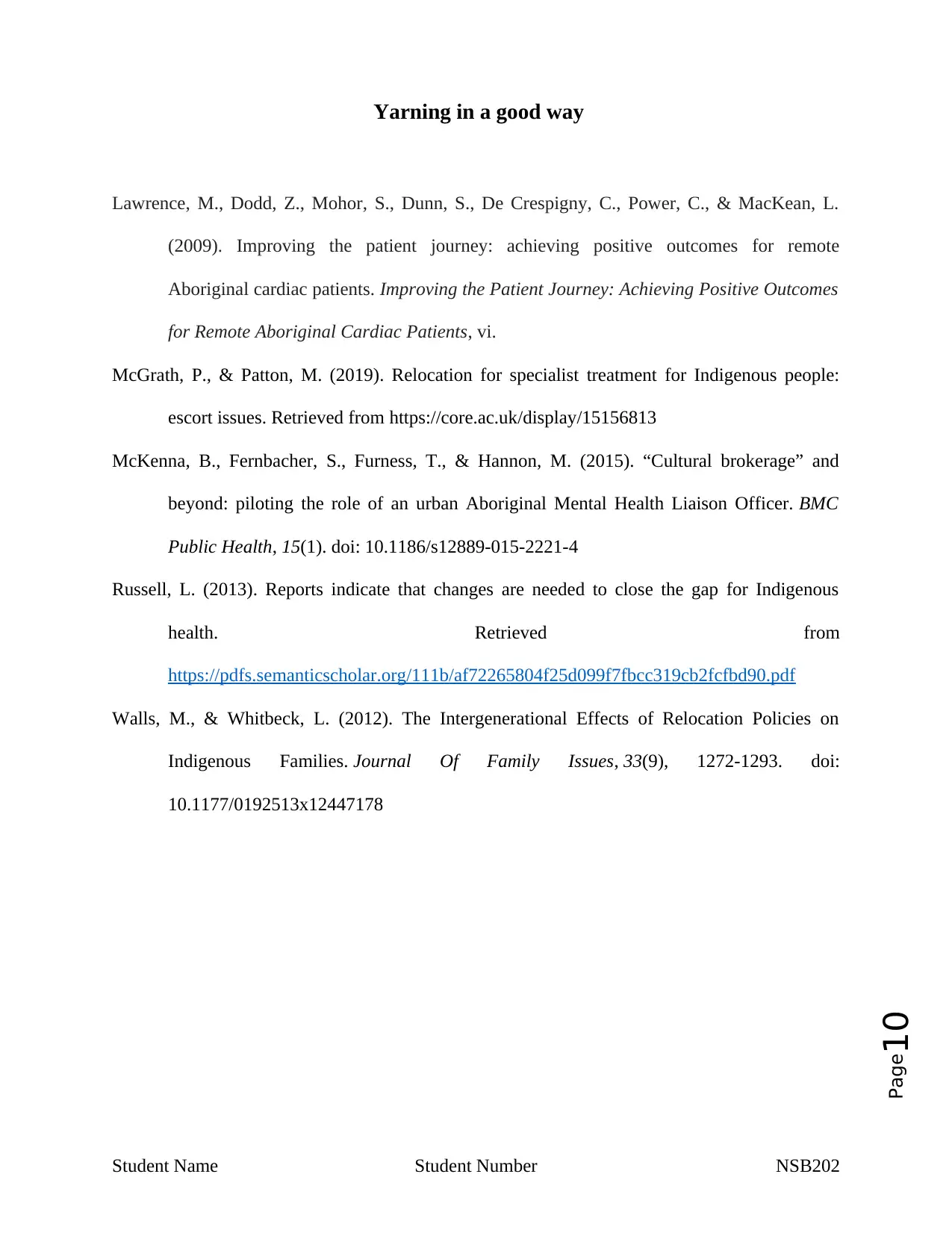
Page10
Yarning in a good way
Lawrence, M., Dodd, Z., Mohor, S., Dunn, S., De Crespigny, C., Power, C., & MacKean, L.
(2009). Improving the patient journey: achieving positive outcomes for remote
Aboriginal cardiac patients. Improving the Patient Journey: Achieving Positive Outcomes
for Remote Aboriginal Cardiac Patients, vi.
McGrath, P., & Patton, M. (2019). Relocation for specialist treatment for Indigenous people:
escort issues. Retrieved from https://core.ac.uk/display/15156813
McKenna, B., Fernbacher, S., Furness, T., & Hannon, M. (2015). “Cultural brokerage” and
beyond: piloting the role of an urban Aboriginal Mental Health Liaison Officer. BMC
Public Health, 15(1). doi: 10.1186/s12889-015-2221-4
Russell, L. (2013). Reports indicate that changes are needed to close the gap for Indigenous
health. Retrieved from
https://pdfs.semanticscholar.org/111b/af72265804f25d099f7fbcc319cb2fcfbd90.pdf
Walls, M., & Whitbeck, L. (2012). The Intergenerational Effects of Relocation Policies on
Indigenous Families. Journal Of Family Issues, 33(9), 1272-1293. doi:
10.1177/0192513x12447178
Student Name Student Number NSB202
Yarning in a good way
Lawrence, M., Dodd, Z., Mohor, S., Dunn, S., De Crespigny, C., Power, C., & MacKean, L.
(2009). Improving the patient journey: achieving positive outcomes for remote
Aboriginal cardiac patients. Improving the Patient Journey: Achieving Positive Outcomes
for Remote Aboriginal Cardiac Patients, vi.
McGrath, P., & Patton, M. (2019). Relocation for specialist treatment for Indigenous people:
escort issues. Retrieved from https://core.ac.uk/display/15156813
McKenna, B., Fernbacher, S., Furness, T., & Hannon, M. (2015). “Cultural brokerage” and
beyond: piloting the role of an urban Aboriginal Mental Health Liaison Officer. BMC
Public Health, 15(1). doi: 10.1186/s12889-015-2221-4
Russell, L. (2013). Reports indicate that changes are needed to close the gap for Indigenous
health. Retrieved from
https://pdfs.semanticscholar.org/111b/af72265804f25d099f7fbcc319cb2fcfbd90.pdf
Walls, M., & Whitbeck, L. (2012). The Intergenerational Effects of Relocation Policies on
Indigenous Families. Journal Of Family Issues, 33(9), 1272-1293. doi:
10.1177/0192513x12447178
Student Name Student Number NSB202
1 out of 10
Related Documents
Your All-in-One AI-Powered Toolkit for Academic Success.
+13062052269
info@desklib.com
Available 24*7 on WhatsApp / Email
![[object Object]](/_next/static/media/star-bottom.7253800d.svg)
Unlock your academic potential
Copyright © 2020–2025 A2Z Services. All Rights Reserved. Developed and managed by ZUCOL.





